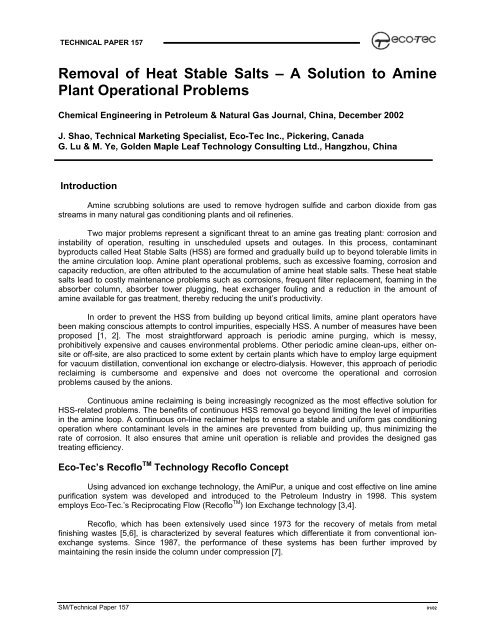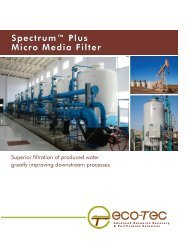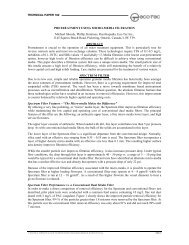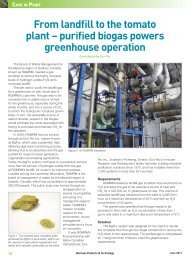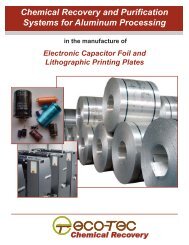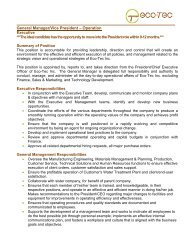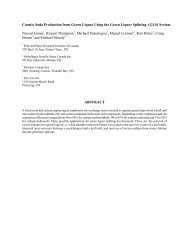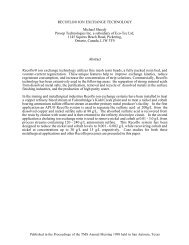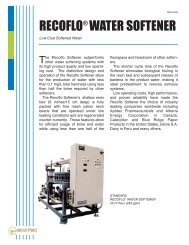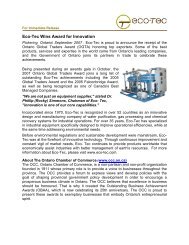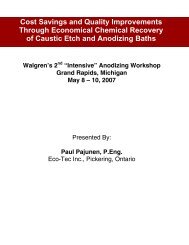Removal of Heat Stable Salts – A Solution to Amine Plant ... - Eco-Tec
Removal of Heat Stable Salts – A Solution to Amine Plant ... - Eco-Tec
Removal of Heat Stable Salts – A Solution to Amine Plant ... - Eco-Tec
Create successful ePaper yourself
Turn your PDF publications into a flip-book with our unique Google optimized e-Paper software.
TECHNICAL PAPER 157<br />
<strong>Removal</strong> <strong>of</strong> <strong>Heat</strong> <strong>Stable</strong> <strong>Salts</strong> – A <strong>Solution</strong> <strong>to</strong> <strong>Amine</strong><br />
<strong>Plant</strong> Operational Problems<br />
Chemical Engineering in Petroleum & Natural Gas Journal, China, December 2002<br />
J. Shao, <strong>Tec</strong>hnical Marketing Specialist, <strong>Eco</strong>-<strong>Tec</strong> Inc., Pickering, Canada<br />
G. Lu & M. Ye, Golden Maple Leaf <strong>Tec</strong>hnology Consulting Ltd., Hangzhou, China<br />
Introduction<br />
<strong>Amine</strong> scrubbing solutions are used <strong>to</strong> remove hydrogen sulfide and carbon dioxide from gas<br />
streams in many natural gas conditioning plants and oil refineries.<br />
Two major problems represent a significant threat <strong>to</strong> an amine gas treating plant: corrosion and<br />
instability <strong>of</strong> operation, resulting in unscheduled upsets and outages. In this process, contaminant<br />
byproducts called <strong>Heat</strong> <strong>Stable</strong> <strong>Salts</strong> (HSS) are formed and gradually build up <strong>to</strong> beyond <strong>to</strong>lerable limits in<br />
the amine circulation loop. <strong>Amine</strong> plant operational problems, such as excessive foaming, corrosion and<br />
capacity reduction, are <strong>of</strong>ten attributed <strong>to</strong> the accumulation <strong>of</strong> amine heat stable salts. These heat stable<br />
salts lead <strong>to</strong> costly maintenance problems such as corrosions, frequent filter replacement, foaming in the<br />
absorber column, absorber <strong>to</strong>wer plugging, heat exchanger fouling and a reduction in the amount <strong>of</strong><br />
amine available for gas treatment, thereby reducing the unit’s productivity.<br />
In order <strong>to</strong> prevent the HSS from building up beyond critical limits, amine plant opera<strong>to</strong>rs have<br />
been making conscious attempts <strong>to</strong> control impurities, especially HSS. A number <strong>of</strong> measures have been<br />
proposed [1, 2]. The most straightforward approach is periodic amine purging, which is messy,<br />
prohibitively expensive and causes environmental problems. Other periodic amine clean-ups, either onsite<br />
or <strong>of</strong>f-site, are also practiced <strong>to</strong> some extent by certain plants which have <strong>to</strong> employ large equipment<br />
for vacuum distillation, conventional ion exchange or electro-dialysis. However, this approach <strong>of</strong> periodic<br />
reclaiming is cumbersome and expensive and does not overcome the operational and corrosion<br />
problems caused by the anions.<br />
Continuous amine reclaiming is being increasingly recognized as the most effective solution for<br />
HSS-related problems. The benefits <strong>of</strong> continuous HSS removal go beyond limiting the level <strong>of</strong> impurities<br />
in the amine loop. A continuous on-line reclaimer helps <strong>to</strong> ensure a stable and uniform gas conditioning<br />
operation where contaminant levels in the amines are prevented from building up, thus minimizing the<br />
rate <strong>of</strong> corrosion. It also ensures that amine unit operation is reliable and provides the designed gas<br />
treating efficiency.<br />
<strong>Eco</strong>-<strong>Tec</strong>’s Rec<strong>of</strong>lo TM <strong>Tec</strong>hnology Rec<strong>of</strong>lo Concept<br />
Using advanced ion exchange technology, the AmiPur, a unique and cost effective on line amine<br />
purification system was developed and introduced <strong>to</strong> the Petroleum Industry in 1998. This system<br />
employs <strong>Eco</strong>-<strong>Tec</strong>.’s Reciprocating Flow (Rec<strong>of</strong>lo TM ) Ion Exchange technology [3,4].<br />
Rec<strong>of</strong>lo, which has been extensively used since 1973 for the recovery <strong>of</strong> metals from metal<br />
finishing wastes [5,6], is characterized by several features which differentiate it from conventional ionexchange<br />
systems. Since 1987, the performance <strong>of</strong> these systems has been further improved by<br />
maintaining the resin inside the column under compression [7].<br />
SM/<strong>Tec</strong>hnical Paper 157 01/02
TECHNICAL PAPER 157<br />
These features include:<br />
• Fine particle size resins;<br />
• Countercurrent regeneration;<br />
• Short column heights (3 <strong>to</strong> 36 inch);<br />
• Low resin loading;<br />
• Fast flows and short cycles;<br />
These on line <strong>Eco</strong>-<strong>Tec</strong> <strong>Amine</strong> Purification (AmiPur) systems are now successfully operating in many<br />
Petroleum Refineries in North America.<br />
AmiPur – <strong>Heat</strong> <strong>Stable</strong> Salt <strong>Removal</strong> System<br />
In 1998 <strong>Eco</strong>-<strong>Tec</strong> developed a system for the removal <strong>of</strong> anionic impurities from alkanolamine<br />
water solutions, which was named AmiPur – the name easily recognized and accepted by amine gas<br />
treatment plants worldwide.<br />
<strong>Eco</strong>-<strong>Tec</strong> <strong>of</strong>fers several models <strong>of</strong> AmiPur,<br />
with different HSS removal capacities. A<br />
typical AmiPur unit is presented at Figure 1.<br />
Figure 1. Skid-mounted AmiPur unit.<br />
Skid size: 160 x 160 x 250 cm<br />
HSS removal capacity: 25 – 70 kg/day<br />
There are basically two steps in the AmiPur operating cycle: HSS loading and caustic<br />
regeneration. This cycle is au<strong>to</strong>matically repeated every 20 minutes.<br />
During the HSS loading portion <strong>of</strong> the cycle, lean amine solution is pumped through a cartridge<br />
filter and in<strong>to</strong> the resin column. The ion exchange resin removes the heat stable salts and the purified<br />
amine solution is directed <strong>to</strong> the flash tank or returned in<strong>to</strong> the amine batch.<br />
MDEA<br />
DEA<br />
MEA<br />
Formate<br />
Thiocyanate<br />
Acetate<br />
Thiosulfate<br />
Sulfate<br />
Oxalate<br />
Chloride<br />
Total HSS<br />
1<br />
2<br />
3<br />
4<br />
5<br />
6<br />
7<br />
8<br />
1<br />
2<br />
3<br />
4<br />
5<br />
6<br />
7<br />
8<br />
0 0.5 1 1.5 2 2.5 3<br />
0 0.5 1 1.5 2 2.5 3<br />
0 1 2 3 4 5 6 7<br />
Figure 2 Anion removal by AmiPur, <strong>Eco</strong>-<strong>Tec</strong> labora<strong>to</strong>ry data<br />
SM/<strong>Tec</strong>hnical Paper 157 01/02
TECHNICAL PAPER 157<br />
Dilute caustic soda is used <strong>to</strong> regenerate the resin column. The unit draws concentrated caustic<br />
from tanks or drums and dilutes it <strong>to</strong> the proper strength au<strong>to</strong>matically, then this solution is then pumped<br />
through the column and remove the HSS.<br />
After several minutes <strong>of</strong> regeneration, the system rinses the excessive caustic from the resin and<br />
a new cycle starts.<br />
An initial AmiPur system was installed at the Crown Central Petroleum Corporation (CCPC). The<br />
analysis <strong>of</strong> AmiPur “in” and “out” streams demonstrated that in addition <strong>to</strong> the removal <strong>of</strong> acetate,<br />
formate, thiocyanate and other anions, AmiPur also reduced iron level. This, <strong>to</strong>gether with significant<br />
formate removal capacity, resulted in a dramatic decrease in corrosion rates and filter pluggage at the<br />
Pasadena refinery.<br />
Since that time AmiPur has been successfully tested on all the major types <strong>of</strong> amines (Figure 2).<br />
Significant decreases are observed on all types <strong>of</strong> HSS level after the installation <strong>of</strong> an AmiPur. Existing<br />
installations are operating on MDEA and DEA solutions, both at main amine and tail gas units, and have<br />
resulted in significant operating benefits for the amine plants.<br />
Case His<strong>to</strong>ry: Crown Central Petroleum Corporation<br />
This refinery has both primary and tail gas amine treating systems. MDEA is used at the present<br />
time in both amine systems.<br />
The primary amine unit contains a gas liquid contac<strong>to</strong>r or fuel gas absorber, a spare fuel gas<br />
absorber, a liquid-liquid C3/C4 amine treater, one amine regenera<strong>to</strong>r, a flash drum, heat exchangers,<br />
amine filter, a slipstream amine reclaimer, and several associated pumps. For the main fuel gas<br />
absorber, the <strong>to</strong>wer’s pressure drop is measured over the inlet gas line <strong>to</strong> outlet gas line, and this ∆P is<br />
used <strong>to</strong> moni<strong>to</strong>r <strong>to</strong>wer pluggage and foaming.<br />
The liquid-liquid amine contac<strong>to</strong>r is a trayed <strong>to</strong>wer with 15 trays. It is designed <strong>to</strong> remove about<br />
1,000 PPM H 2 S from 21,000 BPD C3/C4 mix.<br />
The tail gas unit’s amine system is very similar <strong>to</strong> the main amine system, with no flash drum and<br />
only a single amine absorber.<br />
The MDEA amine solution absorbs the H 2 S from the gas and liquid feeding the refiner’s<br />
absorbers, and these absorbers send the rich amine <strong>to</strong> be regenerated in a relatively simple processing<br />
scheme. The amine unit contacts the refinery <strong>of</strong>f gas products from the various unit operations, and while<br />
removing H 2 S, the contact in the absorbers allows the amine <strong>to</strong> react with other species in the gas and<br />
liquid streams, causing the amine <strong>to</strong> chemically degrade. These unwanted reactions are known <strong>to</strong> occur<br />
with oxygen, CO, SO 2 cyanides, organic acids such as formates and acetates, inorganic acids such as<br />
HCl and H 2 SO 4 , all <strong>of</strong> which can and will be present in the <strong>of</strong>f gas products from the refinery.<br />
As HSS build, the amine filters plugged more frequently. A decrease in the amine filter life is<br />
usually the first sign <strong>of</strong> increased corrosivity, as this increase in the corrosivity starts in the hot lean amine<br />
system that feeds the amine filters. If the amine filters do not adequately remove these products <strong>of</strong><br />
corrosion, filter life may not be affected, but the amine solution color will be dark. Dark amine solution<br />
feeding a packed absorber <strong>to</strong>wer will certainly lead <strong>to</strong> <strong>to</strong>wer pluggage and foaming. This foaming then<br />
leads <strong>to</strong> increased amine losses, and the increased amine make up can temporarily reduce the HSS <strong>to</strong><br />
slow the corrosion and Improve the amine quality. As the HSS again start <strong>to</strong> build, the cycle starts again.<br />
There can be no discussion more frustrating than an <strong>Amine</strong> plant discussion. Low level<br />
contaminants in the amine contac<strong>to</strong>rs degrade the MDEA and form the HSS, and accumulation <strong>of</strong> the<br />
salts begins <strong>to</strong> affect amine unit performance. The only way <strong>to</strong> break this frustrating cycle is <strong>to</strong> remove<br />
these salts from the solution continuously and not allow the accumulation.<br />
SM/<strong>Tec</strong>hnical Paper 157 01/02
TECHNICAL PAPER 157<br />
At Crown Central Petroleum’s Pasadena, Texas refinery, an AmiPur reclaiming unit was installed<br />
in 1998 <strong>to</strong> effectively remove HSS from MDEA solution. The unit was purchased in August 1998 and<br />
started up in Oc<strong>to</strong>ber. The HSS in solution were approximately 2.4% when the AmiPur unit was started,<br />
and within 30 days the HSS was down <strong>to</strong> less than 2%. Material that had been accumulated from the unit,<br />
and s<strong>to</strong>red in a tank was then introduced in<strong>to</strong> the amine unit. The HSS level in the solution increased<br />
back <strong>to</strong> 2.4%, as we brought in 3.5% HSS material from the tank. The rented tank was then released, and<br />
the AmiPur unit brought the solution back down <strong>to</strong> 2%. By March 1999, after a unit shutdown for<br />
maintenance, and replacement <strong>of</strong> the amine regenera<strong>to</strong>r <strong>to</strong>wer, the HSS level was down <strong>to</strong> 1.75%. A<br />
significant decrease in the corrosion rate was observed. The ultimate goal <strong>of</strong> the refinery is <strong>to</strong> keep the<br />
corrosion rate as close <strong>to</strong> zero as possible. To achieve this goal it was decided <strong>to</strong> decrease the HSS<br />
concentration further. The AmiPur was designed <strong>to</strong> maintain HSS at about 1.5 wt.%, so the unit was<br />
upgraded <strong>to</strong> provide extra capacity. This work was completed in Oc<strong>to</strong>ber 1999. Since then the HSS level<br />
was decreased <strong>to</strong> 0.4 wt.% as MDEA. HSS level decline is shown in Figure 3 [8,9].<br />
wt.% HSS (as MDEA)<br />
4<br />
3.5<br />
3<br />
AmiPur<br />
installed<br />
TGU amine<br />
added<br />
Average HSS<br />
before AmiPur<br />
7.6 - 2.4 wt %<br />
range<br />
2.5<br />
2<br />
1.5<br />
1<br />
0.5<br />
0<br />
Jul-98<br />
Oct-98<br />
S<strong>to</strong>red<br />
material added<br />
Nov-98<br />
Dec-98<br />
Feb-99<br />
Mar-99<br />
Apr-99<br />
May-99<br />
Jun-99<br />
Jul-99<br />
Aug-99<br />
Sep-99<br />
AmiPur<br />
upgraded<br />
Oct-99<br />
Nov-99<br />
Feb-00<br />
Mar-00<br />
Apr-00<br />
May-00<br />
Initial HSS target<br />
level<br />
New HSS target<br />
level<br />
Figure 3.<br />
HSS level at the main amine unit at CCPC Pasadena refinery<br />
The corrosivity <strong>of</strong> CCPC’s main amine solution has been moni<strong>to</strong>red since 1997 using an<br />
electrical resistance probe, which is installed at the bot<strong>to</strong>m <strong>of</strong> the main amine regenera<strong>to</strong>r. This probe<br />
reading has compared favorably <strong>to</strong> monthly ultrasonic thickness measurements taken by the refinery’s<br />
Inspection Department on the regenera<strong>to</strong>r <strong>to</strong>wer’s shell and the amine piping. Summary graphs <strong>of</strong> these<br />
corrosion probe readings shown in Figure 4 [8,9]. The regenera<strong>to</strong>r <strong>to</strong>wer, built in 1978, was replaced in<br />
early 1999 due <strong>to</strong> the shell’ metal thickness. Since the AmiPur installation it has been possible <strong>to</strong> keep<br />
the corrosion rate at 10 mpy. The average rate for 1999 was 12 mpy. It is not unusual <strong>to</strong> get zero reading<br />
since the HSS level dropped below 1 wt.% as MDEA.<br />
The tail gas amine unit has also been connected <strong>to</strong> the AmiPur unit <strong>to</strong> allow removing the HSS<br />
from this amine unit, eliminating the need for “bleed and feed” and reducing the amine consumption<br />
associated with this operation. The flexibility that the AmiPur unit provides allows the removal <strong>of</strong> the HSS<br />
from either <strong>of</strong> the amine systems on a campaign type approach. The present plan is <strong>to</strong> maintain both<br />
amine systems at HSS levels below 2%.<br />
SM/<strong>Tec</strong>hnical Paper 157 01/02
TECHNICAL PAPER 157<br />
MPY<br />
70.00<br />
60.00<br />
50.00<br />
40.00<br />
30.00<br />
20.00<br />
10.00<br />
0.00<br />
1997 Ave 1998 Ave 1999 Ave 2000 Ave<br />
Figure 4.<br />
Yearly average corrosion probe readings, mills per year; 1997-2000<br />
Summary and Conclusions<br />
<strong>Amine</strong> unit operation is an important part <strong>of</strong> the refinery’s environmental compliance. <strong>Amine</strong><br />
degradation causes the formation <strong>of</strong> heat stable amine salts (HSS) that can lead <strong>to</strong> corrosion. The amine<br />
unit performance begins <strong>to</strong> deteriorate as the HSS increase, and the H 2 S absorber becomes less stable.<br />
Iron in solution increases, amine filter life starts <strong>to</strong> fall, and equipment corrosion and fouling can lead <strong>to</strong><br />
an unscheduled outage.<br />
One <strong>of</strong> the most important results <strong>of</strong> an AmiPur installation is the STABLE and RELIABLE<br />
operation <strong>of</strong> the amine plant, which in turn has a dramatic environmental impact. The continuous removal<br />
<strong>of</strong> HSS has immediate and easily quantifiable results: reduction <strong>of</strong> filtration costs; elimination <strong>of</strong> periodic<br />
chemical cleaning <strong>of</strong> the absorber <strong>to</strong>wer; improved gas treating capacity <strong>of</strong> the unit (due <strong>to</strong> increased<br />
amount <strong>of</strong> amine available for gas treating); elimination or reduced use <strong>of</strong> antifoamers, neutralizers and<br />
corrosion inhibi<strong>to</strong>rs; elimination <strong>of</strong> the cost associated with previously used methods <strong>of</strong> HSS removal.<br />
AmiPur, installed at Crown Central Petroleum, demonstrated the benefits <strong>of</strong> continuous removal <strong>of</strong> HSS<br />
for the refinery operation, Table 1 [8,9]. The project demonstrated a payback in the range <strong>of</strong> four(4)<br />
months, exceeding original projections for a six month payback.<br />
SM/<strong>Tec</strong>hnical Paper 157 01/02
TECHNICAL PAPER 157<br />
Table 1.<br />
Benefits <strong>of</strong> AmiPur Installation at CCPC Pasadena Refinery<br />
HSS incursion rate: 1 wt. % per month (as MDEA)<br />
<strong>Amine</strong> inven<strong>to</strong>ry: 15,000 Usgal<br />
Item Description Benefit Annual<br />
savings<br />
(USD)<br />
HSS concentration decreased from avg.<br />
3.5 <strong>to</strong> 0.4 wt.% as<br />
reliable operation<br />
MDEA<br />
<strong>Amine</strong> foaming Height/break<br />
tendency<br />
parameters changed<br />
from 450/23 <strong>to</strong> 50/4<br />
Power for reboiler lower fouling <strong>of</strong><br />
heatexchangers<br />
Chemical cleaning decreased from 3<br />
<strong>of</strong> the absorber times per year <strong>to</strong> zero<br />
<strong>to</strong>wer<br />
Corrosion<br />
decreased from avg.<br />
60 mpy <strong>to</strong> avg. 12<br />
mpy<br />
Filter replacement<br />
<strong>Amine</strong> inven<strong>to</strong>ry<br />
replacement<br />
frequency decreased<br />
several times<br />
amount <strong>of</strong> free amine<br />
increased by 3.1 wt.%<br />
(as HSS level<br />
decreased from avg.<br />
3.5 <strong>to</strong> avg. 0.4 wt.%)<br />
less foaming -<br />
operating benefits<br />
lower energy<br />
consumption<br />
eliminated cost $16,500<br />
great long-term<br />
maintenance savings<br />
labor and material<br />
savings<br />
More amine is<br />
available <strong>to</strong> treat acid<br />
gas; cost savings<br />
and operating<br />
benefits<br />
$23,000<br />
Other costs Elimination <strong>of</strong> $35,000<br />
previously used<br />
practice <strong>of</strong> HSS<br />
control<br />
Reduced amine lower and more cost savings $120,00<br />
loss<br />
consistent absorber<br />
0<br />
feed rates (less<br />
fouling and foaming)<br />
Additives antifoamer use cost savings $300<br />
eliminated<br />
SM/<strong>Tec</strong>hnical Paper 157 01/02
TECHNICAL PAPER 157<br />
Literature Cited<br />
1. Simmons C. V. Proceedings <strong>of</strong> Laurance Reid Gas Conditioning Conference, March 4-6, 1991,<br />
Norman, OK<br />
2. Burns D., George R. A. Proceedings <strong>of</strong> the 74 th GPA Annual Convention, 95-103<br />
3. Hunter R.F. US Patent No 3,385,788 (May 28, 1968)<br />
4. Hunter R.F. US Patent No 3,386,914 (June 4, 1968)<br />
5. Brown C.J., in separation processes in hydrometallurgy., Ed. G.A. Davies. Chichester, England: Ellis<br />
Horwood Publishers., 379-392 (1987)<br />
6. Brown C.J., Fletcher C.J. Ion-exchange for industry. Ed. M. Streat, Chichester, England: Ellis<br />
Horwood Publishers., 392-403 (1988)<br />
7. Brown C. US Patent No 4,673,507 (June 16, 1987)<br />
8. Daria J., Davy P., Sheedy M. The 2000 Laurance Reid Gas Conditioning Conference, February 27 –<br />
March 1, 2000, Norman, OK<br />
9. Davy P., Daria J. Brims<strong>to</strong>ne Sulfur Recovery Symposium, September 14 – 17, 1999, Colorado<br />
SM/<strong>Tec</strong>hnical Paper 157 01/02


